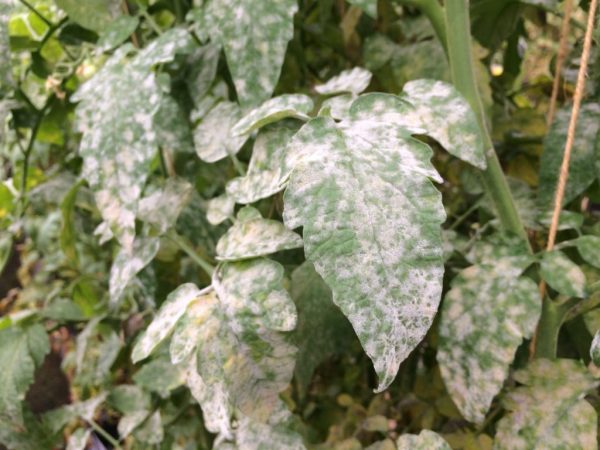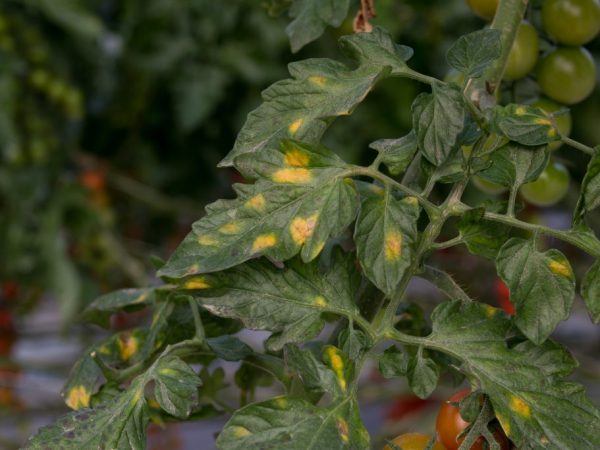Reasons for the appearance of white leaves in tomatoes in a greenhouse
Today tomatoes are one of the most popular foods that are always found on the table. Only sometimes it is quite difficult to grow them even in a greenhouse, as there are times when white spots may appear on the strongest and healthiest bushes. And not many gardeners know what caused this, and how to deal with them. White leaves of tomatoes in a greenhouse - what could be the reason?

Reasons for the appearance of white leaves in tomatoes in a greenhouse
Causes of white spots
Even though tomatoes are a “not difficult” crop, sometimes problems can arise with them, especially if grown in a greenhouse, although a greenhouse is one hundred percent guarantee that the crop should definitely grow. But sometimes, due to the fact that there may be temperature drops and poor ventilation in the greenhouse, a number of problems may appear. Most often it happens due to the fact that they fall under the sun's rays, while they were not previously prepared for this. Tomatoes have very delicate leaves.
If these are sunburns, they usually only affect the top leaves of the plant. In addition, this can happen due to the fact that the seedlings were not previously prepared for planting in the ground. Therefore, in order to avoid this, the first seedlings must be kept outside under the sun for at least several hours a day so that they get used to it. If this is not possible, then you can put them on the windowsill, there they can be left for the whole day.
If you have not done this, then it is best when planting to immediately cover them for the first time, so that the sun does not fall on the plant. The first 11-15 days the bushes will get used to the soil, and it is possible that they may not like it and then white mold may appear as a "protest" to the soil.
Diseases of the tomato
The most common diseases with white spots on tomatoes are:
- such an ailment as - septoria;
- white spot in tomatoes;
- a great lack of many minerals, and as a result, the appearance of plaque.
The latter problem occurs due to the fact that tomatoes are planted every year in the same place, and at the same time, without giving the necessary amount of fertilizer, and then the earth takes all the minerals for itself, is completely depleted and as a result, the plants do not receive additional vitamins and get sick ... Tomatoes don't have a strong immune system at first.
White rot
Have you noticed that the leaves are turning white? This is a fungal disease that, in fact, is quite rare, but still occurs. The disease affects, most often, it is new, young seedlings that have not yet been able to build their immunity in a greenhouse. The nature of the disease when the leaves turn white:
- plants in their structure from a solid state to a softer one, and mucus appears on the leaves;
- at the very beginning of the stem, they appear as white bags, they resemble, as if a spider has woven a cobweb;
- the color of the pillar itself becomes dark and not bright;
- as a result, after a while the plant loses its appearance, dries up and dies: after that, it is difficult for tomatoes to restore the root system.
A similar disease appears, most often, due to the fact that the temperature in the room very often drops down, and remains there. In addition, poor ventilation in the greenhouse affects. Therefore, if you notice such symptoms in your plants, then you need to start treating them immediately.
- All particles that are already infected with the disease must be immediately cut off and destroyed so that the disease does not spread to other bushes.
- All places where you cut off the branches must be processed so that there is no new infection.
- Then absolutely all plants must be sprayed with a special mixture, it can be copper sulphate or a Bordeaux-type liquid.
Watch the temperature carefully, it should not drop much and stay at the same level, also carefully watch the humidity. If the temperature is low and the humidity is high, this can lead to the progression of the disease.
Brown spot

The disease develops from high humidity
Most often, a similar ailment begins to manifest itself in those moments when all the fruits on the bushes begin to ripen and develop. An interesting fact is that a similar ailment affects certain parts of the bush:
- a small fluff may appear on the underside of all leaves, which will be white;
- over time, such a fluff can change its color from white to a darker one, and its structure will more resemble not fluff, but rot;
- but the upper part of the leaf will also change its color and instead of greenish it will become light yellow with a dirty shade of brown;
- also another characteristic feature of the disease is that then all the leaves are wrapped in a tube and dry up, in tomatoes this is an infrequent phenomenon.
It is this disease that progresses and develops only in greenhouses, where there is a very high percentage of humidity and an increased percentage of temperature. The advice from experienced gardeners is to regularly ventilate the room every day so that the temperature and moisture are always within the normal range. As an excellent method of prevention, it is necessary to spray tomatoes every 6 days with a liquid called "Bordeaux". This is a great way to overcome the disease and prevent it from going into the stage of active reproduction.
Powdery mildew
The disease never affects young bushes, always only ripe and adult plants that already have a strong and good root system. The main causative agent of this disease is a fungus that multiplies in mature spores. Roots can rot in tomatoes. The main "symptoms" of the disease when the leaves turn white:
- it is quite difficult to immediately notice the ailment, since it develops only on the inside of the leaves, they resemble small grains of flour or semolina grains;
- yellowish spots with white dots may appear on the outside of tomato leaves;
- after a while, the leaves begin to dry and fall off sharply.
This ailment is quite difficult to overcome, since it takes root firmly in the tomato system and does not go away. The percentage of 40 to 60 that the tomatoes will be able to survive, and return the bush to its tone and yield. A similar disease appears only when the temperature in the room is constantly changing, and it constantly jumps, then up and down. The plant needs to be watered more, given additional fertilizers and treated with special preparations.
In order to try to save the plant, it is necessary to carry out a number of activities. All infectious parts must be immediately removed and destroyed. It is advisable to somehow change the first layer of earth in other bushes, since particles of the disease could remain there on top. Then absolutely all bushes should be treated by spraying with such a preparation as "Tsineba".
Prevention of white spots
In order to prevent trouble, you can use the advice of experienced breeders and carry out the prevention of tomatoes.
- Pre-treatment of all planting seeds will be an excellent prevention.
- In the event that spotting was noticed on the seedlings, it is necessary to remove the damaged bushes from the site.
- Preventive treatment must be carried out with products that contain a large amount of sulfur.
It is recommended to plant only resistant tomato varieties that are less susceptible to disease.
Conclusion
In fact, there are quite a few reasons why greenhouse tomatoes can develop white spots. The most important thing to remember is that all plants must be sunbathing before planting, and the second is that moisture and temperature must be constantly monitored.
Ventilate the greenhouse for several hours once a day, and then you shouldn't have any problems. When plaque appears, change seedlings and remove leaves. And as soon as a white bloom appears on the tomatoes, spray them with the appropriate preparation.


